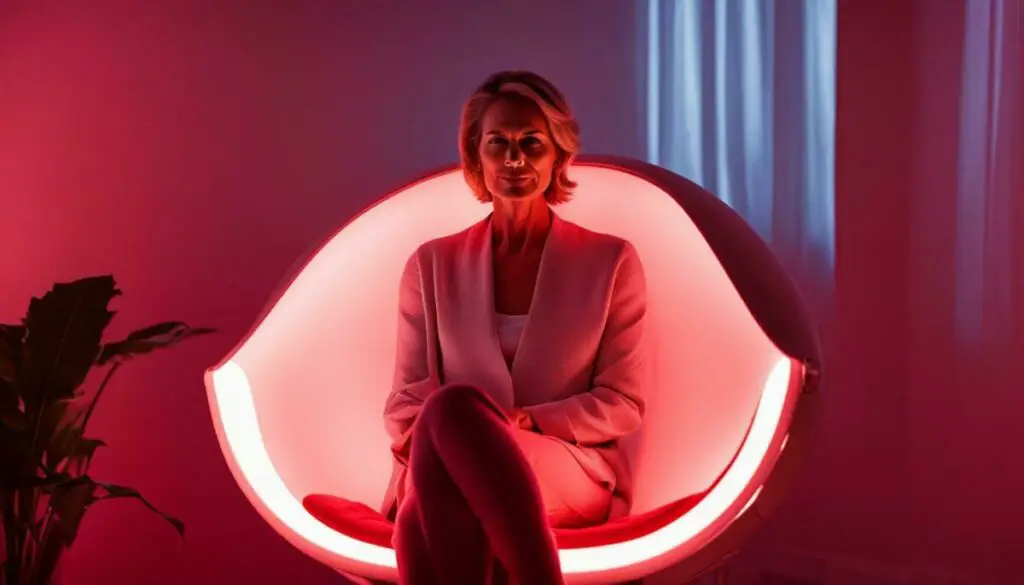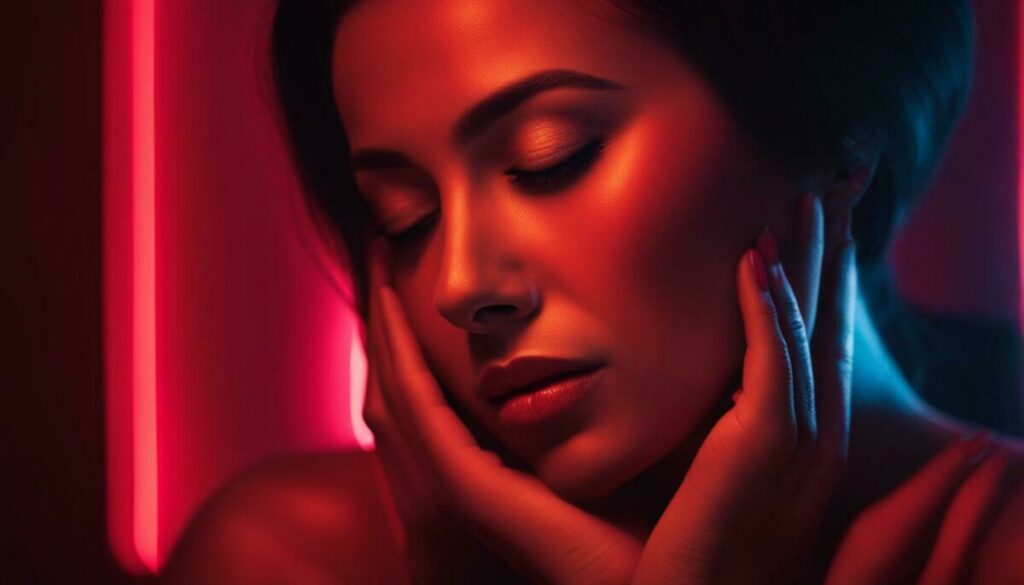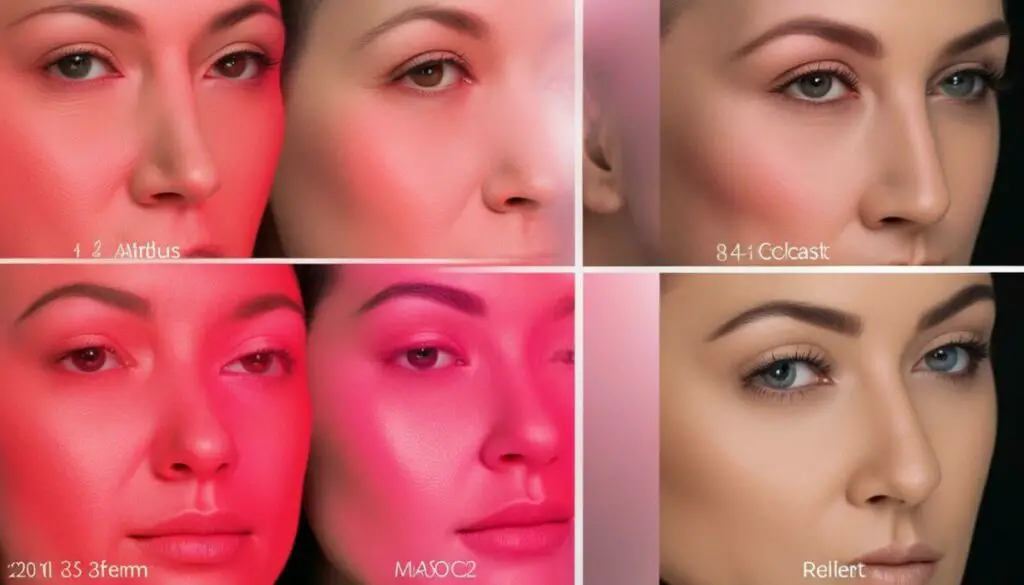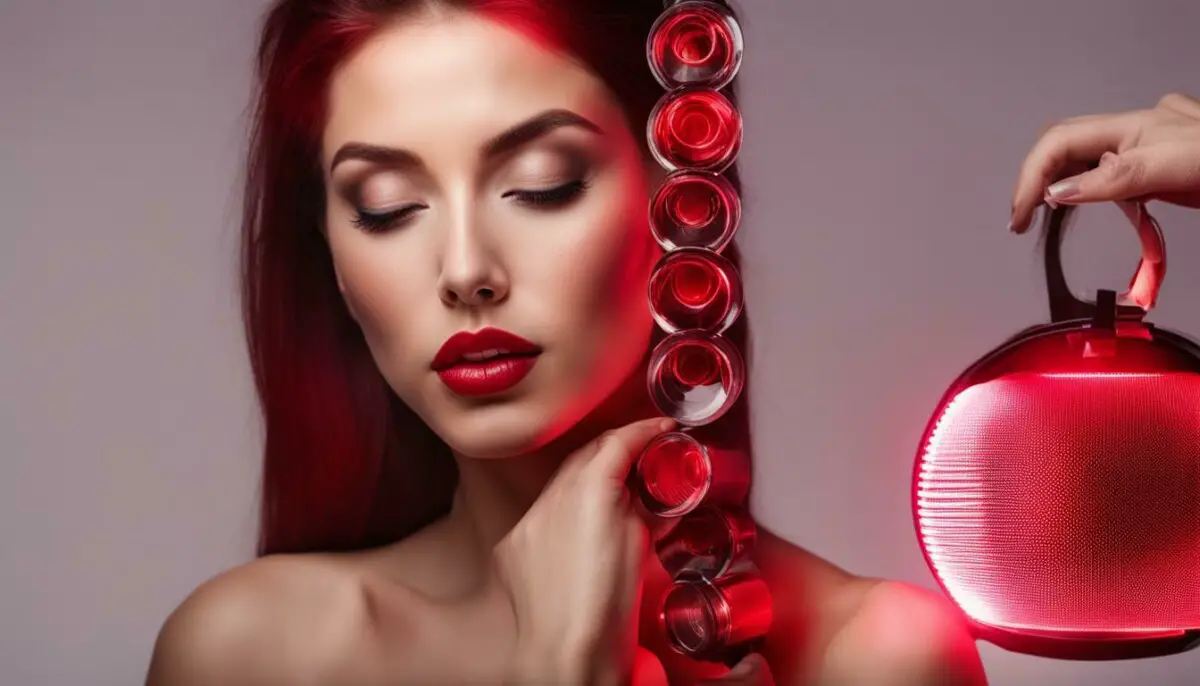Last Updated on 6 months by Francis
Are you considering non-invasive cosmetic treatments for skin rejuvenation and wrinkle reduction? Two popular options on the market are red light therapy and Botox. While both treatments aim to enhance the appearance of the skin, they have distinct differences and benefits.
In this article, we will provide a comprehensive comparison of red light therapy versus Botox. We will explore the effectiveness, risks, and benefits of each treatment to help you make an informed decision about which option may be right for you.
Contents
Key Takeaways:
- Red light therapy and Botox are two non-invasive cosmetic treatments for skin rejuvenation and wrinkle reduction.
- They have distinct differences in effectiveness, risks, and benefits.
- It’s important to consult with a professional to determine which treatment aligns better with your lifestyle and individual needs.
- There are alternative natural anti-aging treatments available besides red light therapy and Botox.
- The future possibilities and advancements in non-invasive skincare options are promising.
Understanding Red Light Therapy
Red light therapy is a non-invasive treatment that uses red light wavelengths to penetrate the skin. This type of therapy has been gaining popularity as a safe and effective way to promote skin rejuvenation and reduce the signs of aging.
One of the main benefits of red light therapy is its ability to stimulate collagen production, which can help to improve skin elasticity and firmness. This, in turn, can reduce the appearance of fine lines and wrinkles and promote a more youthful-looking complexion.
Red light therapy is also beneficial for skin rejuvenation because it can increase circulation and promote cellular repair. By improving circulation, red light therapy helps to deliver vital nutrients and oxygen to the skin, which can support its natural healing processes and improve overall skin health.
In addition to its skin-related benefits, red light therapy has been shown to have positive effects on the body as a whole. It can help to reduce inflammation, which is a common cause of many health problems, and promote tissue repair and regeneration.
Overall, red light therapy is a versatile treatment that offers numerous benefits for both the skin and the body. Its non-invasive nature and minimal side effects make it an appealing option for those looking for a natural way to improve their appearance and promote overall health.

Exploring Botox
Botox is a popular cosmetic treatment that involves injecting a purified form of botulinum toxin into targeted muscles to temporarily paralyze them and reduce the appearance of wrinkles and fine lines. However, if you are looking for an alternative to Botox, there are several options available.
One such option is red light therapy, which we will discuss in more detail later in this article. However, it is important to note that while red light therapy can provide benefits for skin rejuvenation, it may not have the same wrinkle-reducing effects as Botox.
If you are considering Botox or looking for alternatives, it is important to consult with a trusted skincare professional to determine the best course of action for your specific needs and goals. They may recommend alternative treatments such as dermal fillers, chemical peels, or even natural remedies.
| Botox | Red Light Therapy |
|---|---|
| Temporary paralyzes muscles | Stimulates collagen and elastin production |
| Reduces appearance of wrinkles and fine lines | Can improve skin texture and tone |
| Administered via injection | Non-invasive and painless |
Ultimately, the decision between Botox and alternative treatments such as red light therapy comes down to personal preference, goals, and individual circumstances. It is important to weigh the potential risks and benefits of each option and make an informed decision in consultation with a professional.

Effectiveness of Red Light Therapy
Red light therapy has gained popularity in recent years as a non-invasive treatment option for reducing wrinkles and promoting skin rejuvenation. But just how effective is it?
Studies have shown that red light therapy can indeed be effective in reducing the appearance of wrinkles and fine lines. One study conducted in 2014 found that participants who received red light therapy treatments experienced a significant reduction in wrinkles, with an average of 81% improvement in overall skin appearance.
Another study published in the Journal of Cosmetic and Laser Therapy in 2018 reported similar findings, showing that red light therapy can significantly improve skin texture, reduce fine lines and wrinkles, and increase collagen production.
While red light therapy may not produce the same dramatic results as more invasive procedures like Botox, it offers a gentler and less risky approach to achieving smoother, more youthful-looking skin. Plus, unlike Botox, red light therapy does not require any downtime for recovery.
Overall, red light therapy can be an effective option for those looking to reduce wrinkles and improve their skin’s appearance without undergoing invasive procedures. It is important to note, however, that individual results may vary and a consultation with a trusted skincare professional is recommended to determine if red light therapy is the right choice for you.

Effectiveness of Botox
Botox has been a popular anti-aging treatment for decades, hailed for its ability to smooth out wrinkles and fine lines. The treatment involves injecting a small dose of botulinum toxin into the muscles, temporarily paralyzing them and preventing them from contracting. The result is a smoother, more youthful appearance.
While Botox is undoubtedly effective in reducing wrinkles, it is not the only option available. For those seeking a non-invasive alternative to Botox, there are several options, including red light therapy.
Botox Alternatives
One of the most significant advantages of red light therapy is that it is a non-invasive treatment, meaning there are no injections or needles required. Instead, red light therapy uses low-level wavelengths of light to stimulate skin cells and boost collagen production. This can result in a reduction in fine lines, wrinkles, and other signs of aging.
In addition, red light therapy is a safe and natural alternative to Botox, without the risk of side effects or adverse reactions. It is also less expensive and requires less maintenance than Botox treatments, making it an attractive option for those seeking sustainable anti-aging solutions.
Botox vs Red Light Therapy
While both Botox and red light therapy are effective in reducing the signs of aging, they work in very different ways. Botox works by temporarily paralyzing the muscles that cause wrinkles, while red light therapy works by stimulating collagen production and cell regeneration.
Another significant difference is the longevity of the effects. Botox treatments typically last between three and six months, after which further injections are required to maintain the results. In contrast, red light therapy provides more gradual but longer-lasting results. With regular treatment, the effects can last for up to six months or even longer.
Ultimately, the choice between Botox and red light therapy will depend on your personal preferences, goals, and lifestyle factors. While Botox is a powerful and effective treatment, it is not without its risks and limitations. For those seeking a natural and non-invasive alternative, red light therapy may be a better option.

Risks and Side Effects
As with any medical or cosmetic treatment, red light therapy and Botox both come with potential risks and side effects that should be considered before making a decision.
Risks of Red Light Therapy
While red light therapy is generally considered safe and non-invasive, there are some potential risks to be aware of. According to a study conducted by the National Institutes of Health, prolonged exposure to red light can lead to skin damage and even skin cancer in some cases. Additionally, individuals with a history of skin cancer or those who are taking certain medications may be at a higher risk for adverse effects.
Other potential risks of red light therapy include eye damage if the light is directed towards the eyes, and burns or irritation if the treatment is administered incorrectly. It is important to consult with a qualified professional and follow their instructions to minimize the risk of adverse effects.
Risks of Botox
While Botox is a widely used cosmetic treatment, it is not without its risks. The most common side effects of Botox injections are temporary and include bruising, swelling, and redness at the injection site. In rare cases, more serious side effects such as muscle weakness, difficulty swallowing, and breathing problems may occur.
Over time, repeated use of Botox can lead to a condition called “Botox resistance,” where the treatment becomes less effective in reducing wrinkles. Additionally, Botox injections can be costly and require regular maintenance treatments to maintain the desired results.
It is essential to discuss the potential risks and side effects of Botox with a qualified professional before undergoing treatment.

Natural Anti-Aging Treatments
While red light therapy and Botox are both viable options for reducing wrinkles and rejuvenating the skin, there are also natural anti-aging treatments that may provide effective results. These options are often gentler on the skin and may be a better fit for those who prefer a more holistic approach to skincare.
One such natural anti-aging treatment is facial massage. Massaging the face stimulates blood flow and lymphatic drainage, helping to reduce puffiness and smooth out wrinkles. There are also various facial massage tools available, such as jade rollers and gua sha stones, that can enhance the benefits of facial massage.
Another option is incorporating antioxidant-rich foods into your diet. Antioxidants protect the skin from damage caused by free radicals, which can contribute to wrinkles and other signs of aging. Foods such as berries, leafy greens, and nuts are excellent sources of antioxidants.
| Treatment | Benefits |
|---|---|
| Facial massage | Stimulates blood flow and lymphatic drainage |
| Antioxidant-rich foods | Protects the skin from free radical damage |

In addition, incorporating vitamin C into your skincare routine can also help reduce the appearance of wrinkles. Vitamin C is a powerful antioxidant that helps to promote collagen production, which can lead to firmer, smoother skin.
It is important to note that natural anti-aging treatments may not provide the same dramatic results as red light therapy or Botox. However, they can be a valuable addition to your skincare routine and may help to maintain the results achieved with these treatments.
Considering Long-Term Effects
It is important to consider the long-term effects of both red light therapy and Botox treatments when deciding which option is right for you. While both treatments have their benefits, they also require long-term maintenance and a commitment to sustaining the results over time.
Red Light Therapy
Red light therapy is a non-invasive treatment that shows promise in reducing the signs of aging and improving skin texture. However, it is important to note that the results of red light therapy may take longer to become evident than with Botox treatments. Additionally, the effects of red light therapy may not be as long-lasting as those of Botox, requiring ongoing treatment to maintain results.
However, one advantage of red light therapy is that it is considered safe for long-term use, making it a sustainable option for those seeking ongoing skin rejuvenation.

Botox
Botox is a popular cosmetic treatment that has been used for many years to reduce the appearance of wrinkles and fine lines. While Botox is highly effective in the short term, it requires regular maintenance to sustain results. Generally, Botox treatments last for three to six months before a touch-up is needed.
However, using Botox for an extended period may lead to a reduction in effectiveness over time. Additionally, there are concerns about the long-term effects of using Botox, and more research is needed to understand the potential implications of ongoing Botox use.
If you decide to pursue Botox as a treatment option, it is important to work with a qualified practitioner who can provide guidance on the appropriate frequency and duration of treatment.
Comparing Long-Term Effects
When comparing the long-term effects of red light therapy and Botox, it is important to consider your personal preferences and goals. While both treatments have their advantages and disadvantages, the choice ultimately comes down to what works best for your lifestyle and preferences.
If you are seeking a safe and sustainable option for skin rejuvenation, red light therapy may be a suitable choice. However, if you are looking for immediate and long-lasting results, Botox may be the better option, provided you are willing to commit to regular maintenance treatments.
Personal Preferences and Lifestyle Factors
When deciding between red light therapy and Botox, it’s important to consider your personal preferences and lifestyle factors. The choice between these treatments may depend on various factors such as your budget, time availability, and individual treatment goals.
Cost: Botox is generally more expensive than red light therapy and requires regular maintenance. Red light therapy is a cheaper long-term option that provides gradual results.
Time commitment: Botox treatments are quick and require minimal downtime. However, red light therapy requires more time commitment for noticeable results, as multiple sessions are needed.
Individual treatment goals: Red light therapy is more suitable for individuals looking for a non-invasive, gradual approach to skin rejuvenation. Botox may be a better option for those seeking quick and noticeable results.
Consulting with a professional can help you understand how these factors may influence your decision. By considering your personal preferences and lifestyle factors, you can make an informed choice between these two treatments.

Consultation and Professional Advice
If you’re considering non-invasive skincare options such as red light therapy and Botox, it’s crucial to seek professional guidance before making a decision. Consulting with a practitioner who specializes in non-invasive cosmetic procedures will help you determine which treatment is best suited to your specific needs.
A professional can evaluate your skin type, fine lines, and wrinkles and provide personalized advice on the most suitable treatment. They can also provide in-depth information on the potential risks and benefits, as well as expected outcomes and recovery time.
When seeking a practitioner, it’s important to ensure they have the necessary qualifications and experience. Look for a professional with a strong reputation, positive reviews, and before-and-after photos to provide evidence of their expertise.
Remember that non-invasive skincare options are medical treatments, and choosing an unqualified practitioner can result in unsatisfactory results and even harm. Make sure to do your research and only trust licensed professionals with a proven track record.
Ultimately, professional guidance is essential in determining which non-invasive skincare option is right for you. By seeking expert advice, you can make a more informed decision and feel confident in your choice.

The Future of Non-Invasive Skincare
Non-invasive skincare options are a popular choice for those seeking cosmetic treatments without the risks and downtime associated with surgery. As technology continues to advance, the options for non-invasive treatments are expanding, providing new possibilities for skin rejuvenation and wrinkle reduction.
One emerging technology gaining attention in the skincare industry is radiofrequency (RF) therapy. This treatment uses RF waves to heat the skin’s deeper layers, stimulating the production of collagen and elastin for tighter, smoother skin. RF therapy can also target fat cells, reducing the appearance of cellulite.
Another promising development is the use of stem cells in skincare treatments. Stem cells have the potential to regenerate and repair damaged tissue, making them a useful tool for anti-aging therapies. Some cosmetic companies are already incorporating stem cells into their products, with promising results.
Aside from these specific technologies, overall trends in non-invasive skincare point towards a preference for more natural ingredients and personalized treatments. Consumers are seeking out products and procedures that align with their values and lifestyles, such as vegan or sustainable options. Personalized, targeted treatments are also becoming more popular, with practitioners using advanced technology to analyze a patient’s skin and tailor a treatment to their specific needs.
As non-invasive skincare options continue to evolve, it is essential to stay informed about the latest advancements and trends. Consulting with a professional can help you navigate the range of options and select the best treatment plan for your unique goals and preferences.

Costs and Accessibility
One of the factors to consider when choosing between red light therapy and Botox is the cost and accessibility of each treatment. While both options can be effective, they differ when it comes to affordability and availability.
Botox treatments can be expensive, with the cost ranging from $300 to $1000 per session depending on the provider and location. Additionally, Botox requires regular treatments every few months to maintain the desired results, which can add up over time.
On the other hand, red light therapy is generally more affordable, with at-home devices available for purchase at a lower cost than Botox treatments. However, to achieve optimal results, multiple sessions may be necessary, which can also add up in cost.
Accessibility is another consideration to keep in mind. Botox treatments are typically available at medical spas or clinics that offer cosmetic services. These establishments may not be easily accessible for everyone, especially those living in rural areas or with limited access to transportation.
Red light therapy, on the other hand, is more easily accessible as it can be done at home with a device. However, it’s important to note that not all red light therapy devices are created equal, so it’s essential to choose a reputable and effective device to ensure the best results.

When considering costs and accessibility, it’s important to weigh the pros and cons of each treatment and determine which option aligns best with your budget and lifestyle. Consulting with a professional can also provide valuable insight into the costs and accessibility of each treatment, helping you make an informed choice.
Conclusion
After exploring the differences and similarities between red light therapy and Botox, it is clear that both treatments have their advantages and drawbacks. Ultimately, the decision to choose one over the other depends on individual preferences and goals.
If you are seeking a non-invasive, low-risk option for skin rejuvenation and wrinkle reduction, red light therapy may be a suitable choice. It has been shown to have positive effects on skin health and, unlike Botox, does not involve injections or potential side effects.
However, if you are seeking more immediate and dramatic results, Botox may be the better option. It has been shown to be effective in reducing wrinkles and enhancing facial appearance, although it does come with potential risks and a higher cost.
Consulting with a Professional
It is important to consult with a professional before deciding on any non-invasive skincare option. They can provide personalized advice based on your individual needs and help you make an informed decision.
When seeking a practitioner, make sure to do your research and choose a reputable one with experience in both red light therapy and Botox. They can provide guidance on which treatment is best suited for your lifestyle, goals, and budget.
The Future of Non-Invasive Skincare
As technology continues to advance, the future of non-invasive skincare looks promising. Emerging treatments and technologies may provide even more options for achieving youthful-looking skin without the need for invasive procedures.
It is important to stay informed and up-to-date on the latest developments in non-invasive skincare. By doing so, you can make the best choice for your skin and maintain a youthful appearance for years to come.
Costs and Accessibility
While both red light therapy and Botox offer non-invasive alternatives to traditional cosmetic procedures, they do come with a cost.
Red light therapy is generally more affordable and can be performed at home with the use of a device. Botox, on the other hand, can be more expensive and requires visits to a professional for treatment.
Accessibility is also a consideration. While red light therapy devices can be purchased for home use, some individuals may not have easy access to a professional for Botox treatments.
Consider the financial and accessibility implications of both treatments before making a decision.
By understanding the benefits and limitations of red light therapy and Botox, consulting with professionals, and considering personal preferences and factors, individuals can make an informed decision about which non-invasive skincare option is right for them.
FAQ
What is the difference between red light therapy and Botox?
Red light therapy uses low-level light to stimulate cellular activity and promote skin rejuvenation, while Botox is an injectable treatment that temporarily relaxes muscles to reduce the appearance of wrinkles.
How does red light therapy work for skin rejuvenation?
Red light therapy works by penetrating the skin to stimulate the production of collagen and elastin, which can improve skin texture, reduce wrinkles, and promote a more youthful appearance.
What are the benefits of red light therapy?
Red light therapy has been shown to improve skin tone and texture, reduce wrinkles and fine lines, promote wound healing, and reduce inflammation.
How does Botox work?
Botox works by temporarily blocking nerve signals to muscles, which relaxes the muscles and reduces the appearance of wrinkles caused by repetitive muscle movements.
What are the alternatives to Botox?
Some alternatives to Botox include dermal fillers, laser resurfacing, chemical peels, and non-surgical skin tightening treatments.
Is red light therapy effective for reducing wrinkles?
Red light therapy has shown promising results in reducing the appearance of wrinkles and fine lines, although individual results may vary.
How effective is Botox in reducing wrinkles?
Botox is highly effective in reducing the appearance of wrinkles caused by muscle contractions, such as frown lines and crow’s feet.
What are the risks and side effects of red light therapy?
Red light therapy is generally considered safe with minimal side effects, but some individuals may experience temporary mild redness or dryness of the skin.
What are the risks and side effects of Botox?
The most common side effects of Botox include temporary bruising, swelling, or redness at the injection site, as well as potential muscle weakness or drooping in the treated area.
Are there any natural anti-aging treatments besides red light therapy and Botox?
Yes, there are various natural anti-aging treatments available, such as proper skincare routines, healthy diet and lifestyle choices, and using antioxidant-rich skincare products.
What are the long-term effects of red light therapy?
The long-term effects of red light therapy can include improved skin texture, reduced wrinkles, and overall skin rejuvenation. However, individual results may vary.
What are the long-term effects of Botox?
The long-term effects of Botox can include a reduction in wrinkles and smoother skin, but regular treatments are necessary to maintain the results.
How do personal preferences and lifestyle factors affect the choice between red light therapy and Botox?
Personal preferences and lifestyle factors, such as cost, time commitment, and individual treatment goals, can greatly influence the decision between red light therapy and Botox. It’s important to consider what aligns best with your needs and preferences.
Why is it important to consult with a professional before choosing between red light therapy and Botox?
Consulting with a professional is crucial because they can assess your specific needs and provide expert advice on which treatment is most suitable for you. They can also ensure proper administration and help minimize any risks or side effects.
What does the future hold for non-invasive skincare options besides red light therapy and Botox?
The field of non-invasive skincare is continually advancing, and new treatments and technologies are being developed. These advancements may provide alternative solutions for skin rejuvenation and wrinkle reduction in the future.
How do the costs and accessibility of red light therapy and Botox compare?
The costs and accessibility of red light therapy and Botox can vary depending on factors such as location, the number of treatments required, and the provider. It’s important to consider the affordability and availability of these options when making a decision.


.jpg)
.jpg)
.jpg)
.jpg)


